Shape Optimization of an Integrated Mast for RCS Reduction of a Stealth Naval Vessel
Abstract
1. Introduction
2. Analysis Procedure
3. Analysis Results
4. Conclusions
Author Contributions
Funding
Institutional Review Board Statement
Informed Consent Statement
Data Availability Statement
Acknowledgments
Conflicts of Interest
References
- Lees, P.A.; Davies, M.R. Computer prediction of RCS for military targets. IEE Proc. F (Radar Signal Process.) 1990, 137, 229–236. [Google Scholar] [CrossRef]
- Knott, E.F.; Shaeffer, J.F.; Tuley, M.T. Radar Cross Section, 2nd ed.; SciTech Publishing: Edison, NJ, USA, 2004; pp. 269–356. ISBN 1-891121-25-1. [Google Scholar]
- Ahn, B.-J. A study on the recent analysis method for the RCS reduction for naval ships. J. Korean Inst. Electromagn. Eng. Sci. 2014, 25, 333–338. [Google Scholar] [CrossRef]
- Ahn, B.-J.; Seo, S. A study on the setting procedure of standard value and design target value for the RCS reduced design for naval ships. J. Korean Inst. Electromagn. Eng. Sci. 2015, 26, 581–588. [Google Scholar]
- Seo, H.P.; Lee, K.H. Integrated mast applied for improving stealth ship performance. J. Korean Assoc. Def. Ind. Stud. 2015, 22, 27–46. [Google Scholar]
- Oh, J.-H.; Oh, K.-S.; Kim, C.-G.; Hong, C.-S. Design of radar absorbing structures using glass/epoxy composite containing carbon black in X-band frequency ranges. Compos. B. Eng. 2004, 35, 49–56. [Google Scholar] [CrossRef]
- Chin, W.S.; Lee, D.G. Development of the composite RAS (radar absorbing structure) for the X-band frequency range. Compos. Struct. 2007, 77, 457–465. [Google Scholar] [CrossRef]
- Choi, W.-H.; Song, W.-H.; Lee, W.-J. Broadband radar absorbing structures with a practical approach from design to fabrication. J. Electromagn. Eng. Sci. 2020, 20, 254–261. [Google Scholar] [CrossRef]
- Lee, I.G.; Yoon, S.H.; Lee, J.S.; Hong, I.P. Design of wideband radar absorbing material with improved optical transmittance by using printed metal-mesh. Electron. Lett. 2016, 52, 555–557. [Google Scholar] [CrossRef]
- Hou, Y.-C.; Liao, W.-J.; Tsai, C.-C.; Chen, S.-H. Planar multilayer structure for broadband broad-angle RCS reduction. IEEE Trans. Antennas Propag. 2016, 64, 1859–1867. [Google Scholar] [CrossRef]
- Kim, G.; Kim, S.; Lee, B. Design of wideband microwave absorber using reactive Salisbury screens with maximum flat reflection. J. Korean Inst. Electromagn. Eng. Sci. 2019, 19, 71–81. [Google Scholar] [CrossRef]
- Kim, K.; Kim, J.-H.; Choi, T.-M.; Cho, D.-S. Development of radar cross section analysis system of naval ships. Inter. J. Nav. Archit. Ocean Eng. 2012, 4, 20–32. [Google Scholar] [CrossRef]
- Kwon, H.-W.; Hong, S.-Y.; Lee, K.-K.; Kim, J.-C.; Na, I.-C.; Song, J.-H. Analysis of radar cross section for advanced naval vessels. J. Korean Soc. Mar. Environ. Saf. 2014, 20, 593–600. [Google Scholar] [CrossRef]
- Hwang, J.-T.; Hong, S.-Y.; Kwon, H.-W.; Kim, J.-C.; Song, J.-H. Analysis of radar cross section for naval vessels with metamaterials and radar absorbing materials. J. Korean Soc. Mar. Environ. Saf. 2015, 21, 737–743. [Google Scholar] [CrossRef]
- Hwang, J.-T.; Hong, S.-Y.; Kwon, H.-W.; Song, J.-H. Analysis of stealth design for naval vessels with wide band metamaterials. J. Korean Inst. Inf. Commun. Eng. 2017, 21, 2206–2212. [Google Scholar]
- Borgese, M.; Usai, P.; Costa, F.; Monorchio, A. Fast RCS prediction of electrically large targets coated with radar absorbing materials. In Proceedings of the 12th European Conference on Antennas and Propagation (EuCAP 2018), London, UK, 9–13 April 2018. [Google Scholar]
- Lee, J.-H.; Ra, Y.-E.; Lee, K.-M.; Jang, J.-S. Design of RCS reduction structure of integrated mast on the destroyer. J. Inst. Korean Electr. Electron. Eng. 2020, 24, 238–242. [Google Scholar]
- Kee, C.Y.; Wang, C.-F. Efficient GPU implementation of the high-frequency SBR-PO method. IEEE Antennas Wirel. Propag. Lett. 2013, 12, 941–944. [Google Scholar] [CrossRef]
- Kim, K.; Kim, J.-H.; Kim, Y.-H.; Cho, D.-S. Numerical investigation on dynamic radar cross section of naval ship considering ocean wave-induced motion. Prog. Electromagn. Res. M 2012, 27, 11–26. [Google Scholar] [CrossRef][Green Version]
- Hwang, J.-T.; Hong, S.-Y.; Kwon, H.-W.; Kim, J.-C.; Song, J.-H. A study on stealth design for exterior equipment arrangement considering the multi-bounce effect. J. Korean Soc. Mar. Environ. Saf. 2017, 23, 918–925. [Google Scholar] [CrossRef]
- Shin, H.; Lee, S.; Park, D.; Shin, J.; Chung, M.; Park, S.; Park, Y.B. Analysis of radar cross section of the integrated mast module for battleship. J. Korean Inst. Electromagn. Eng. Sci. 2017, 28, 584–587. [Google Scholar] [CrossRef]
- Shin, H.; Lee, S.; Park, D.; Shin, J.; Chung, M.; Park, Y.B. Analysis of radar cross section of a battleship equipped with an integrated mast module based on PO and PTD. J. Electromagn. Eng. Sci. 2017, 17, 238–240. [Google Scholar] [CrossRef]
- Ling, H.; Chou, R.-C.; Lee, S.-W. Shooting and bouncing rays: Calculating the RCS of an arbitrarily shaped cavity. IEEE Trans. Antennas Propag. 1989, 37, 194–205. [Google Scholar] [CrossRef]
- Suk, S.; Seo, T.-I.; Park, H.-S.; Kim, H.-T. Multiresolution and grid algorithm in the SBR and its application to the RCS calculation. Microw. Opt. Technol. Lett. 2001, 29, 394–397. [Google Scholar] [CrossRef]
- Gao, P.C.; Tao, Y.B.; Lin, H. Fast RCS Prediction using multiresolution shooting and bouncing ray method on the GPU. Prog. Electromagn. Res. 2010, 107, 187–202. [Google Scholar] [CrossRef]
- CST Microwave Studio. Available online: https://www.cst.com/ (accessed on 16 February 2021).
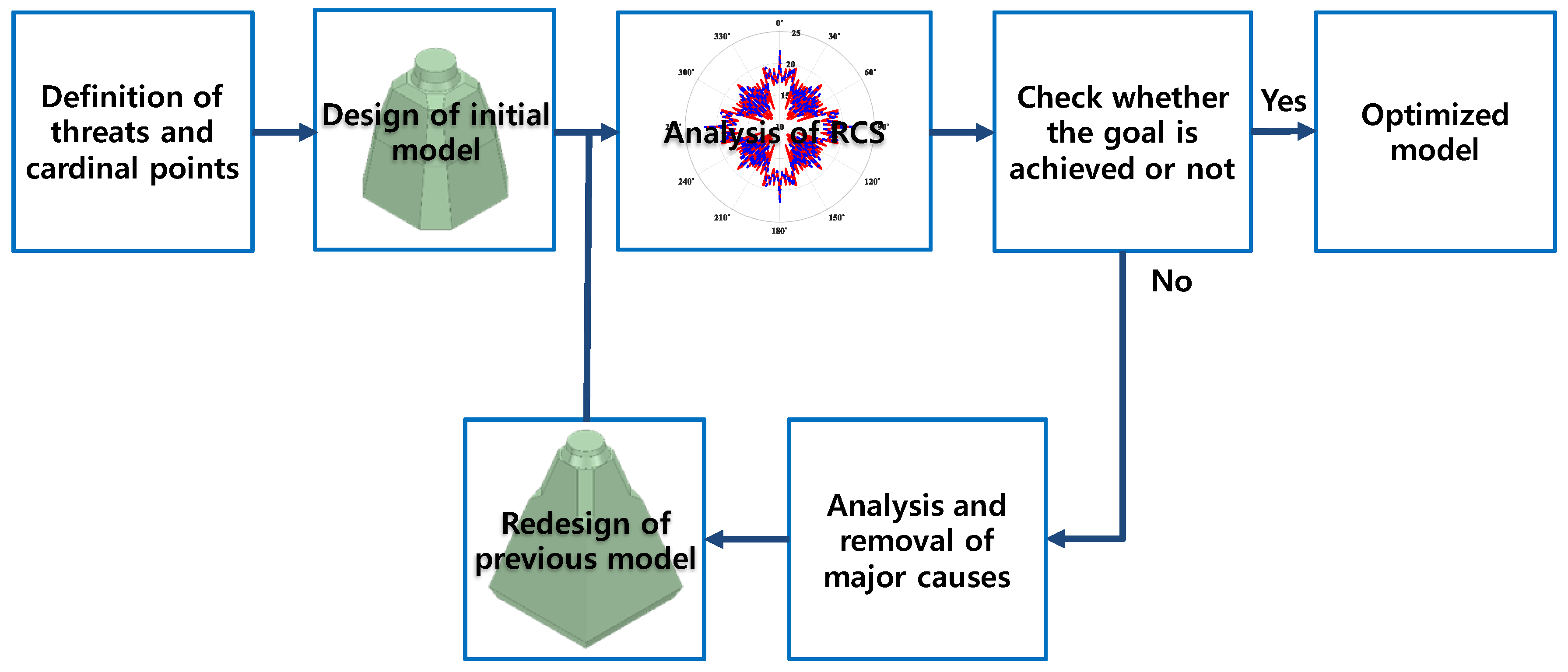
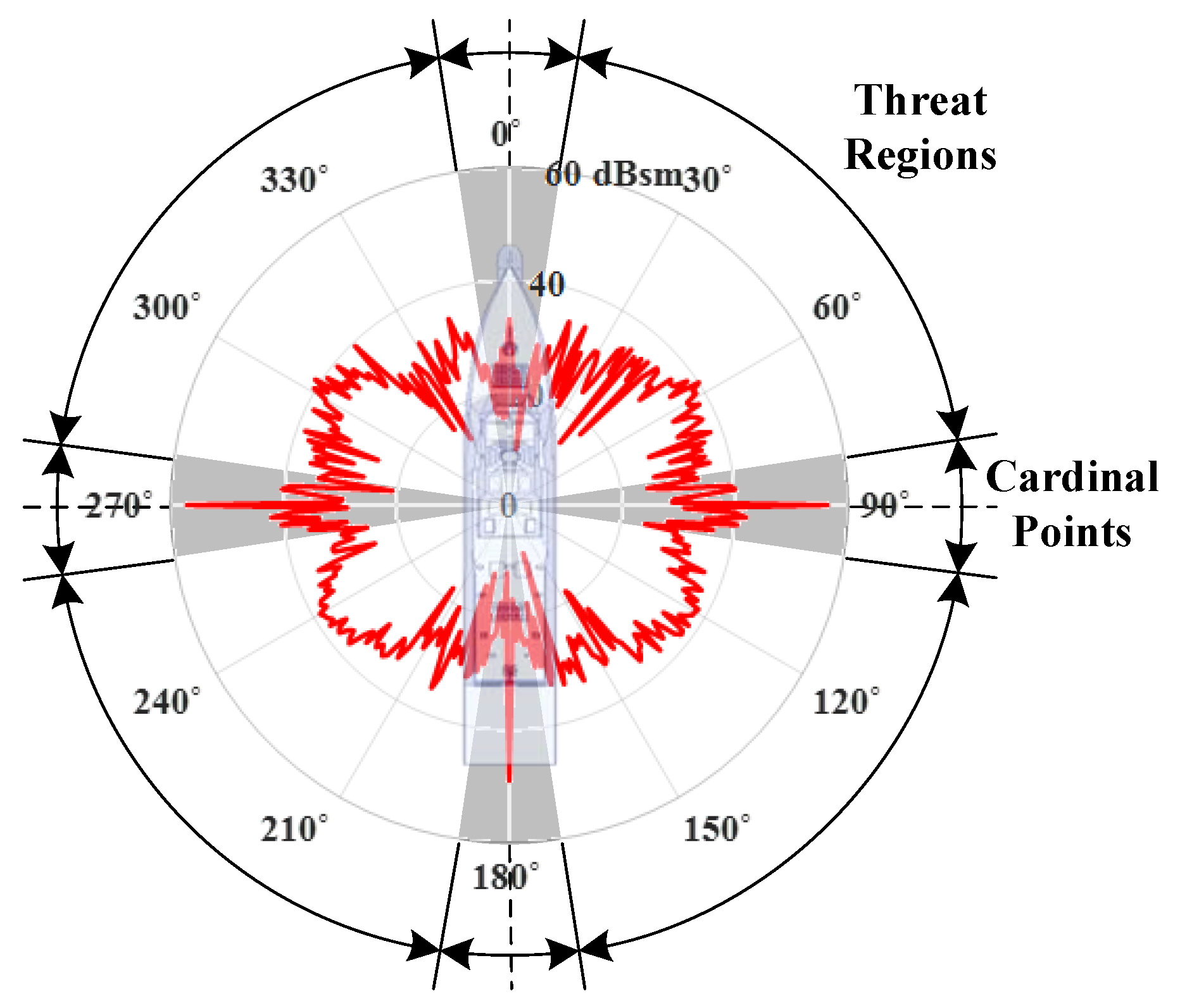
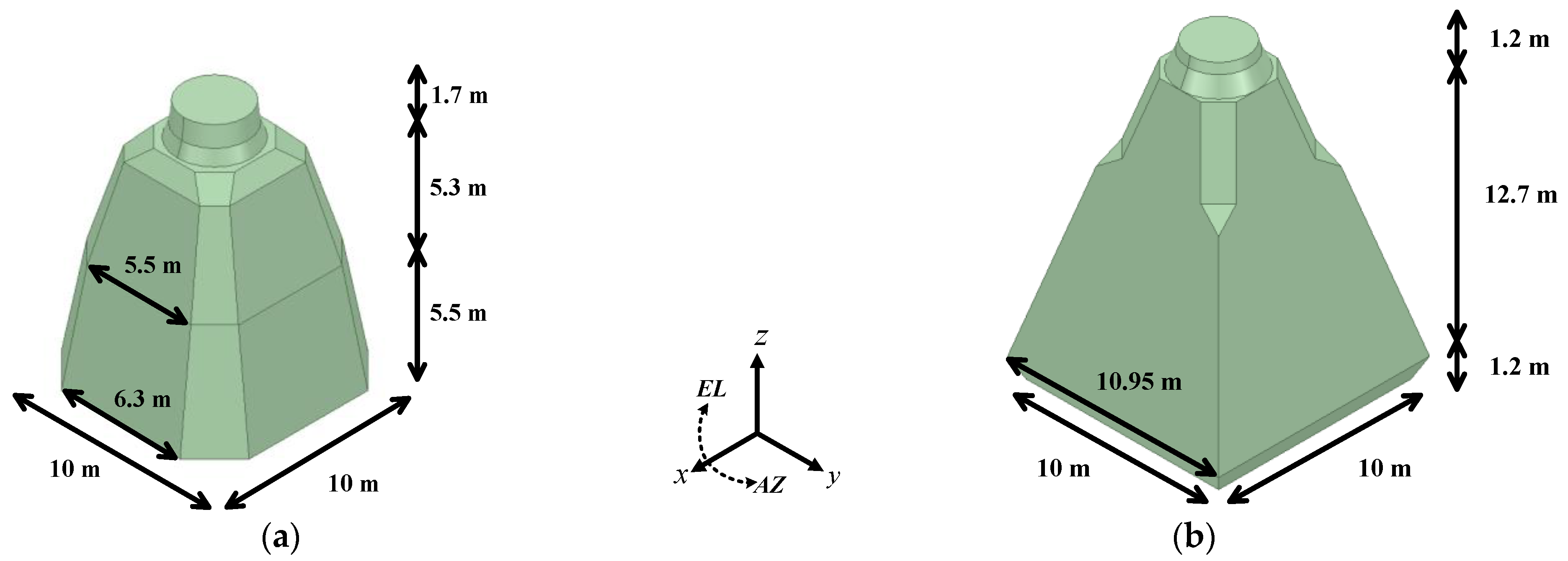



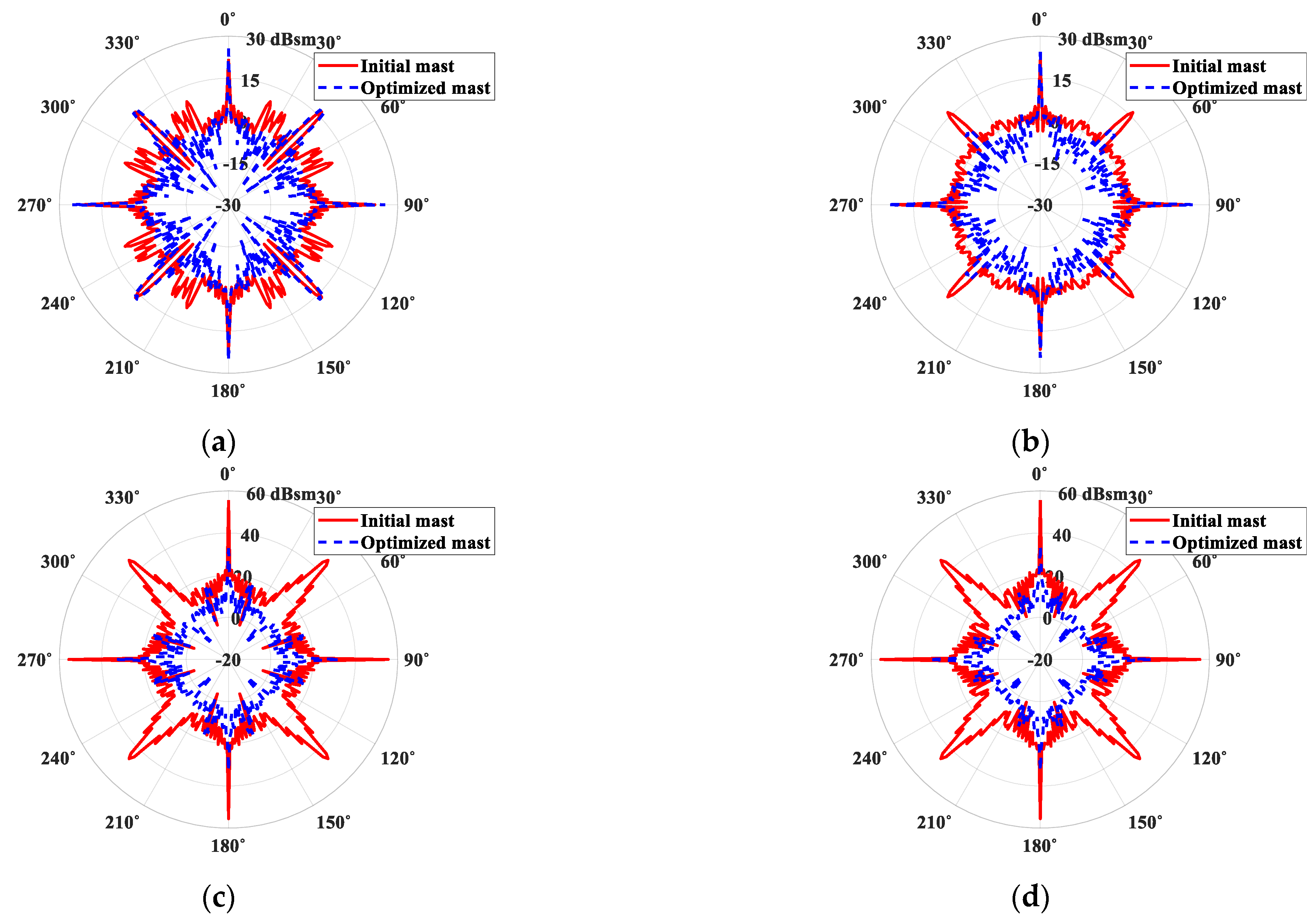

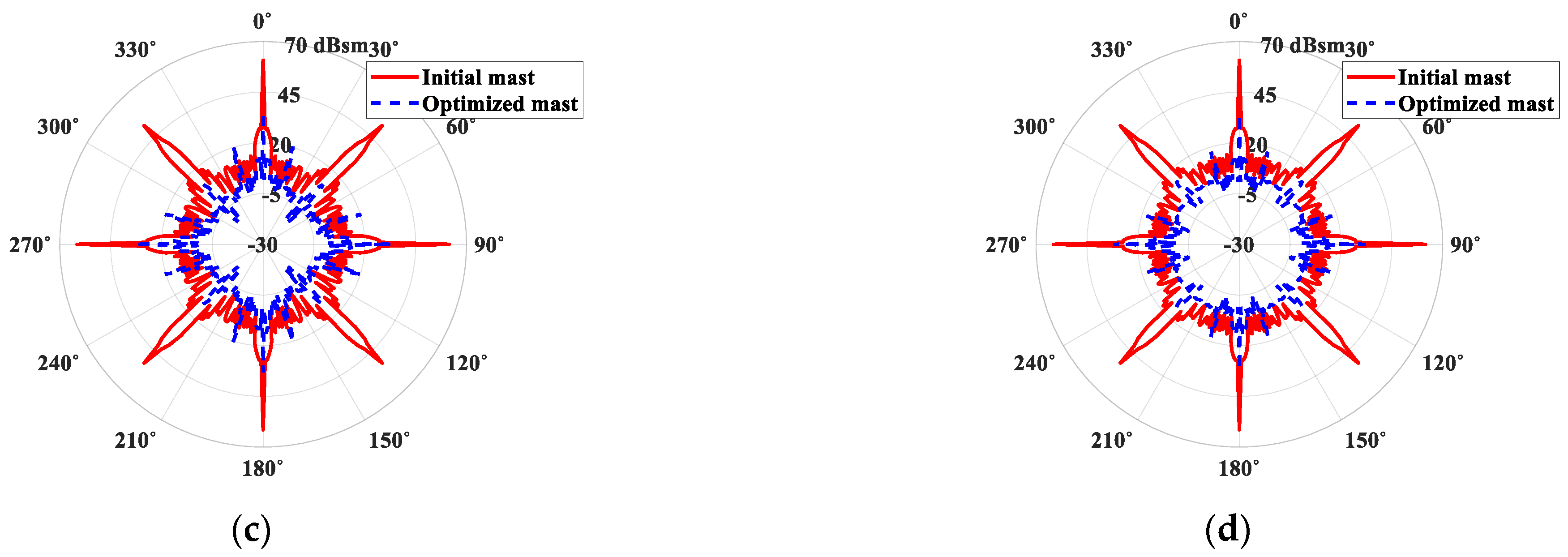
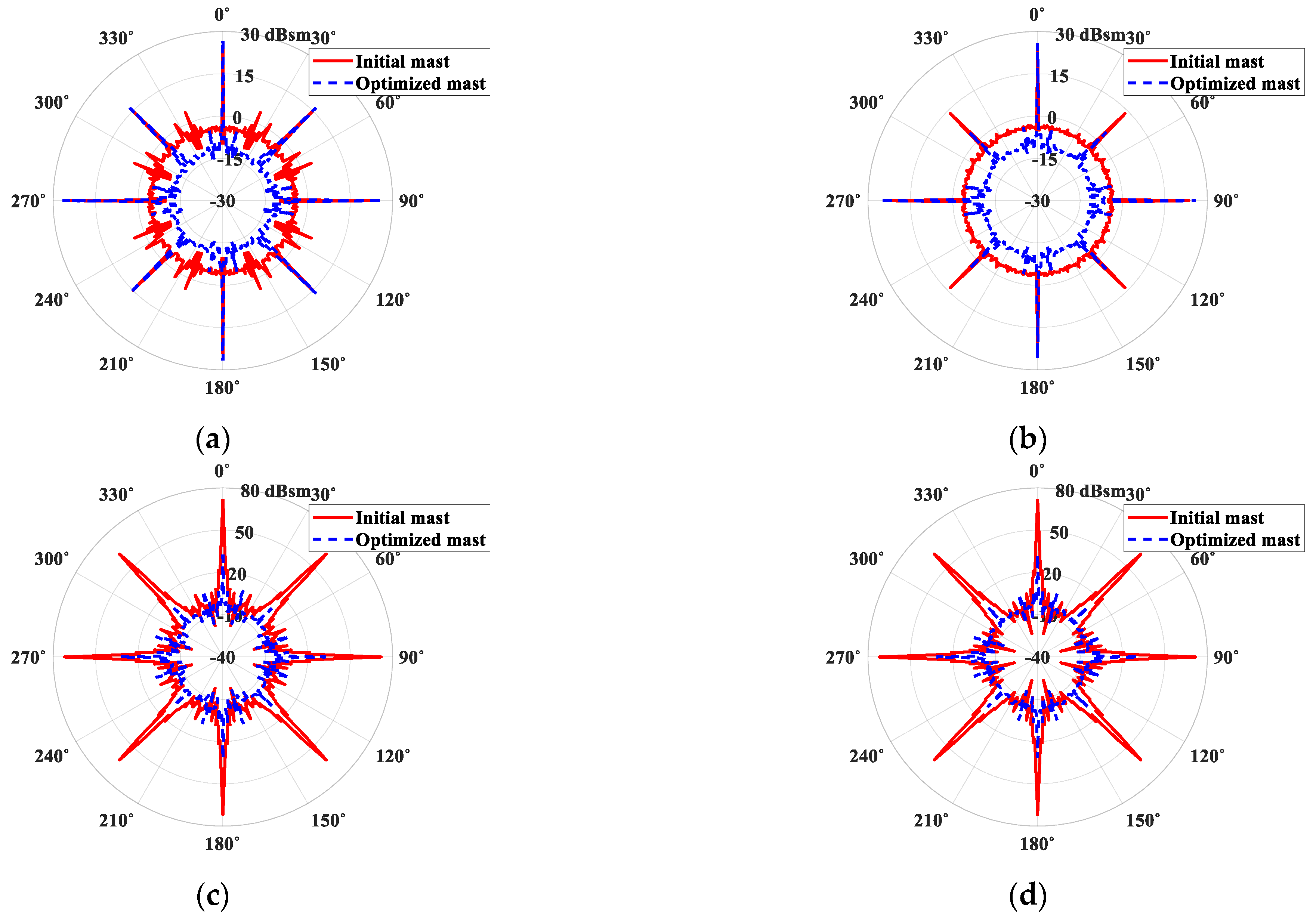
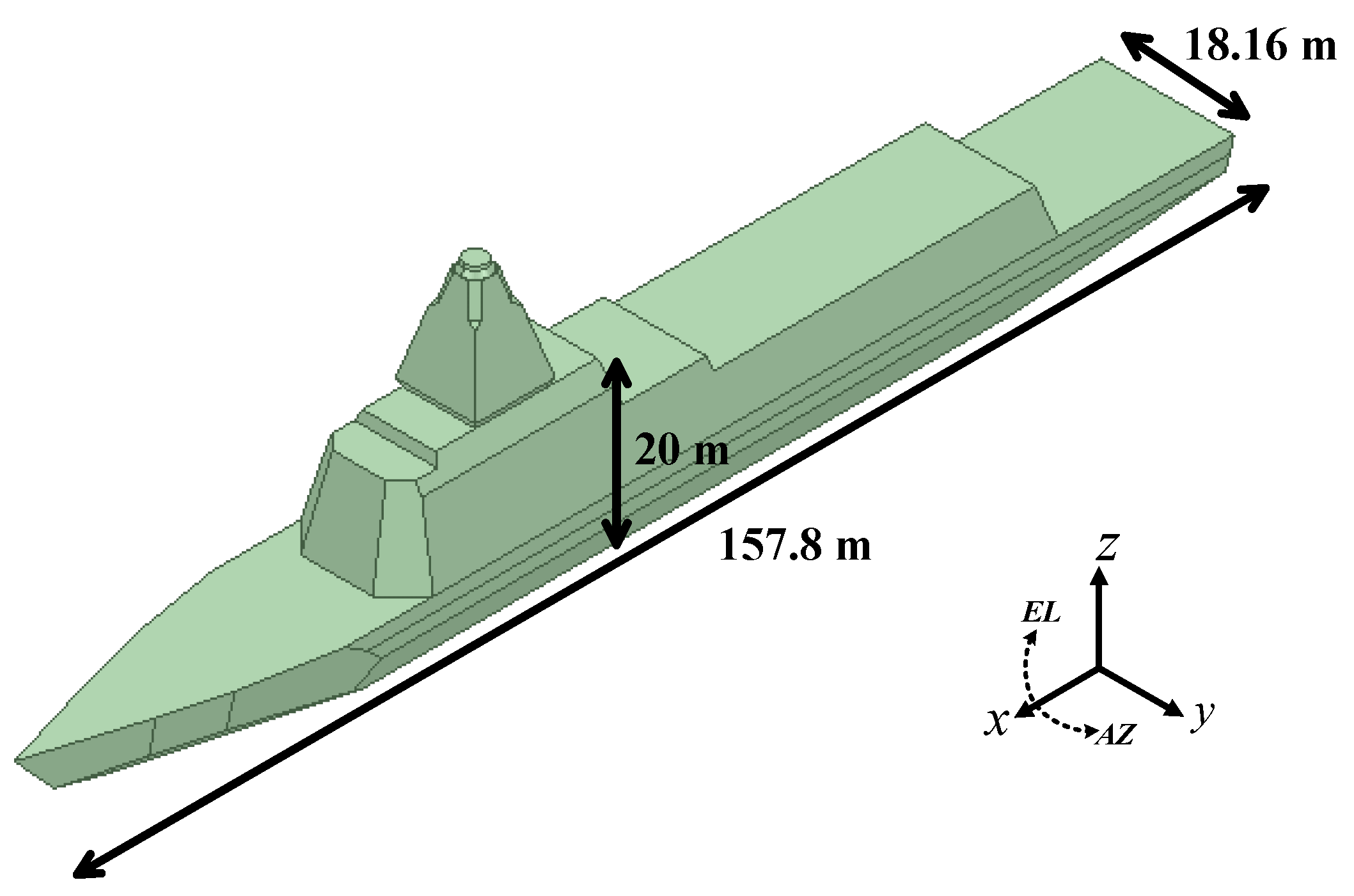


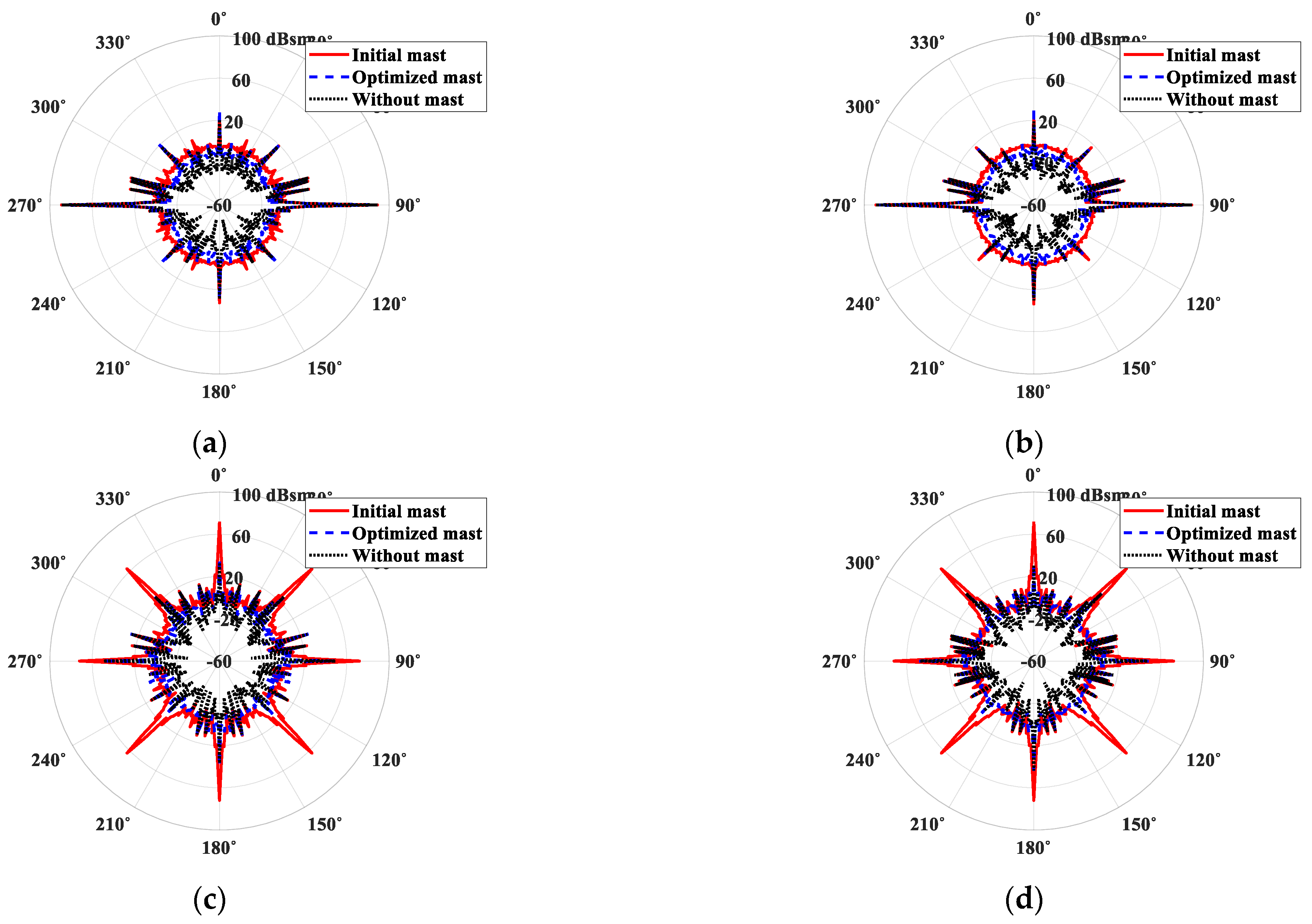
| Frequency | Elevation Angle | Initial Mast | Optimized Mast | ||
|---|---|---|---|---|---|
| HH | VV | HH | VV | ||
| L-band | 0° | 1.69 | 1.75 | −4.04 | −4.13 |
| 3° | 11.23 | 10.40 | −2.78 | −2.15 | |
| 5° | 15.74 | 16.32 | −1.37 | −4.90 | |
| 7° | 18.02 | 17.55 | 3.28 | 4.89 | |
| 10° | 16.91 | 17.00 | 6.02 | 4.89 | |
| S-band | 0° | −1.21 | 0.03 | −5.03 | −3.91 |
| 3° | 5.68 | 7.08 | −8.94 | −11.60 | |
| 5° | 14.92 | 15.37 | −4.49 | −8.07 | |
| 7° | 20.05 | 20.34 | −2.31 | −0.37 | |
| 10° | 11.50 | 13.60 | 0.57 | 3.78 | |
| X-band | 0° | −3.99 | −3.63 | −11.12 | −9.88 |
| 3° | −2.21 | −12.35 | −9.18 | −10.69 | |
| 5° | 6.41 | 7.92 | −8.85 | −4.24 | |
| 7° | 20.22 | 20.14 | −5.17 | −1.99 | |
| 10° | 1.87 | −0.54 | −4.99 | −4.32 | |
| Frequency | Elevation Angle | Initial Mast | Optimized Mast | ||
|---|---|---|---|---|---|
| HH | VV | HH | VV | ||
| L-band | 0° | 5.11 | 4.30 | 4.20 | −1.55 |
| 3° | 11.78 | 10.52 | 3.34 | 0.12 | |
| 5° | 16.24 | 16.58 | 3.77 | 0.42 | |
| 7° | 18.33 | 17.73 | 7.58 | 6.74 | |
| 10° | 31.58 | 31.58 | 8.68 | 6.52 | |
| S-band | 0° | 1.35 | 0.68 | 3.45 | −1.38 |
| 3° | 7.30 | 7.65 | 1.35 | −3.32 | |
| 5° | 15.20 | 15.48 | 1.63 | −2.41 | |
| 7° | 20.21 | 20.42 | 3.77 | 2.66 | |
| 10° | 34.73 | 34.74 | 6.95 | 6.64 | |
| X-band | 0° | −0.74 | −1.53 | −1.81 | −8.56 |
| 3° | 2.46 | −0.14 | −0.64 | −5.98 | |
| 5° | 7.71 | 8.48 | −5.33 | −3.35 | |
| 7° | 20.26 | 20.15 | 0.39 | −0.30 | |
| 10° | 44.33 | 44.33 | −1.78 | −2.13 | |
| Frequency | Elevation Angle | Initial Shape | Optimized Shape | Without Mast | |||
|---|---|---|---|---|---|---|---|
| HH | VV | HH | VV | HH | VV | ||
| L-band | 0° | 3.95 | 2.89 | 0.96 | −1.07 | −2.15 | −6.13 |
| 3° | 11.98 | 11.08 | 2.54 | 1.86 | −1.98 | −2.74 | |
| 5° | 16.05 | 16.61 | 3.28 | 1.07 | −1.72 | −2.60 | |
| 7° | 18.13 | 17.88 | 5.90 | 6.18 | 0.12 | −1.99 | |
| 10° | 17.62 | 17.30 | 8.42 | 6.89 | 2.34 | 0.92 | |
| S-band | 0° | 1.16 | 1.08 | −1.72 | −2.27 | −6.99 | −11.47 |
| 3° | 6.77 | 7.88 | −2.81 | −4.88 | −7.27 | −8.26 | |
| 5° | 15.23 | 15.57 | −0.56 | −3.02 | −7.43 | −7.66 | |
| 7° | 20.07 | 20.23 | 0.78 | 1.31 | −5.23 | −6.44 | |
| 10° | 12.30 | 13.91 | 3.58 | 5.27 | −2.66 | −4.30 | |
| X-band | 0° | −3.05 | −2.97 | −9.23 | −8.68 | −18.13 | −21.46 |
| 3° | −0.87 | −8.51 | −6.37 | −7.61 | −15.17 | −16.32 | |
| 5° | 6.79 | 8.35 | −7.11 | −2.86 | −15.30 | −16.68 | |
| 7° | 20.15 | 20.20 | −3.90 | −0.82 | −14.55 | −15.82 | |
| 10° | 3.58 | 1.76 | −2.44 | −2.04 | −12.03 | −13.07 | |
| Frequency | Elevation Angle | Initial Shape | Optimized Shape | Without Mast | |||
|---|---|---|---|---|---|---|---|
| HH | VV | HH | VV | HH | VV | ||
| L-band | 0° | 11.10 | 8.75 | 11.00 | 8.04 | 9.99 | 7.26 |
| 3° | 13.72 | 12.53 | 10.11 | 8.99 | 9.18 | 8.48 | |
| 5° | 17.10 | 17.63 | 10.27 | 8.91 | 9.06 | 7.77 | |
| 7° | 18.89 | 18.67 | 11.21 | 10.86 | 9.22 | 9.06 | |
| 10° | 31.70 | 31.86 | 13.24 | 12.78 | 10.64 | 11.07 | |
| S-band | 0° | 9.89 | 8.83 | 10.62 | 8.47 | 9.12 | 7.83 |
| 3° | 10.62 | 11.33 | 8.67 | 8.58 | 8.12 | 8.05 | |
| 5° | 16.00 | 16.23 | 8.48 | 8.03 | 7.44 | 7.63 | |
| 7° | 20.45 | 20.52 | 8.70 | 8.69 | 7.42 | 7.56 | |
| 10° | 34.69 | 34.66 | 10.80 | 10.91 | 8.35 | 9.27 | |
| X-band | 0° | 9.66 | 8.69 | 9.89 | 8.44 | 9.32 | 8.20 |
| 3° | 8.78 | 7.87 | 8.79 | 8.27 | 8.06 | 8.03 | |
| 5° | 9.81 | 10.21 | 7.05 | 6.92 | 6.71 | 6.39 | |
| 7° | 20.26 | 20.36 | 7.28 | 8.10 | 6.43 | 7.07 | |
| 10° | 44.39 | 44.41 | 9.57 | 10.48 | 8.77 | 9.94 | |
Publisher’s Note: MDPI stays neutral with regard to jurisdictional claims in published maps and institutional affiliations. |
© 2021 by the authors. Licensee MDPI, Basel, Switzerland. This article is an open access article distributed under the terms and conditions of the Creative Commons Attribution (CC BY) license (http://creativecommons.org/licenses/by/4.0/).
Share and Cite
Shin, H.; Yoon, D.; Kim, C.; Yang, Y.S.; Lee, M.G.; Park, J.Y.; Hwang, K.C.; Park, Y.B. Shape Optimization of an Integrated Mast for RCS Reduction of a Stealth Naval Vessel. Appl. Sci. 2021, 11, 2819. https://doi.org/10.3390/app11062819
Shin H, Yoon D, Kim C, Yang YS, Lee MG, Park JY, Hwang KC, Park YB. Shape Optimization of an Integrated Mast for RCS Reduction of a Stealth Naval Vessel. Applied Sciences. 2021; 11(6):2819. https://doi.org/10.3390/app11062819
Chicago/Turabian StyleShin, Hokeun, Daeyeong Yoon, Chanyeong Kim, Young Sub Yang, Man Gyu Lee, Joon Young Park, Keum Cheol Hwang, and Yong Bae Park. 2021. "Shape Optimization of an Integrated Mast for RCS Reduction of a Stealth Naval Vessel" Applied Sciences 11, no. 6: 2819. https://doi.org/10.3390/app11062819
APA StyleShin, H., Yoon, D., Kim, C., Yang, Y. S., Lee, M. G., Park, J. Y., Hwang, K. C., & Park, Y. B. (2021). Shape Optimization of an Integrated Mast for RCS Reduction of a Stealth Naval Vessel. Applied Sciences, 11(6), 2819. https://doi.org/10.3390/app11062819






